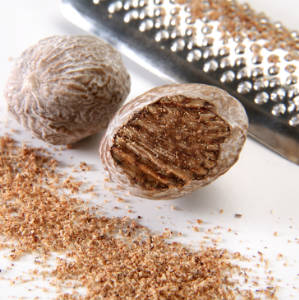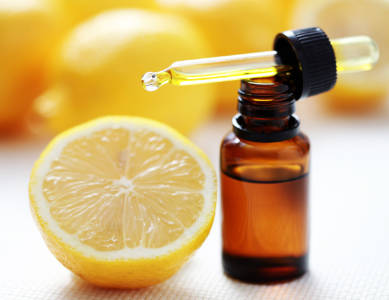Flavorings Category

Includes sweeteners, herbs, spices, chocolate, and extracts.
nutmeg
Freshly grated whole nutmeg tastes far better than packaged ground nutmeg, and has a much longer shelf life.
Learn moreogbono
You can buy these seeds either whole or ground at African markets. Nigerians grind them and use them to thicken stews, to which they add a distinctive flavor and a slimy texture.
Learn moreoil of bitter almonds
This is a very potent flavoring oil that's sold in small bottles and measured by the drop. Natural bitter almond oil isn't available in the United States since it's slightly toxic, but you can buy a synthetic version in bakers' supply shops or through mail order companies. Don't confuse this with the mildly flavored almond oil that's used in savory dishes.
Learn moreoil of lemon
This comes from lemon peels, and it's so concentrated that it's usually measured by the drop. Don't confuse it with lemon extract, which is diluted with alcohol and not nearly as concentrated as the oil. Recipes for hard candies usually call for a flavoring oil rather than an extract, since extracts tend to evaporate when heated.
Learn moreoil of orange
This comes from orange peels, and is so concentrated that it's usually measured by the drop. Don't confuse it with orange extract, which is diluted with alcohol and not nearly as concentrated as the oil. Recipes for hard candies usually call for a flavoring oil rather than an extract, since extracts tend to evaporate when heated.
Learn moreOld Bay seasoning
This is a mixture that combines celery seed, black pepper, salt, paprika, mustard seed, red pepper, bay leaves, cloves, allspice, ginger, mace, cardamom, and cinnamon. To make your own: See the recipe for Old Bay seasoning posted on RecipeSource.com.
Learn moreopal basil
Opal basil has purple leaves and a longer shelf life than sweet basil, but the two can be used interchangeably in most recipes.
Learn moreorange bitters
Orange bitters is made from sour orange peels. Popular brands include Angostura and Fee. A dash or two will perk up your martini, barbecue sauce, chocolate dessert, and seafood.
Learn moreorange flower water
This is distilled from bitter orange blossoms, and it's used to flavor drinks, salads, and desserts. Look for it in Middle Eastern markets and specialty shops.
Learn moreorange marmalade
This is made by boiling the fruit and peel of oranges with sugar, pectin, and water. It manages to be bitter, sour, and sweet all at once, which many people find delightful.
Learn moreoregano
Oregano is a popular herb in Mediterranean countries, where it's often used to season tomato sauces, meat dishes, and pizzas. Mexican oregano has a mintier taste than ordinary oregano. If you can't find it fresh, dried oregano is a good substitute.
Learn moreorgeat
This sweet almond-flavored syrup is used in many mixed drinks. Look for it in liquor stores. To make your own: See the Almond Syrup recipe on the ichef website.
Learn moreoyster plant
These hard to find and expensive leaves taste a little like oysters. Oyster plants are low growing perennial herb in the borage family.
Learn moreoyster sauce
This Cantonese dipping sauce is both sweet and salty. Look for bottles of it in Asian markets and large supermarkets.
Learn morepalm sugar
Look for this is Indian or Asian markets. It should crumble when you squeeze it.
Learn morepalm vinegar
This cloudy white vinegar is popular in the Philippines. It's milder than wine or cider vinegars.
Learn morepancake syrup
This is the inexpensive version of maple syrup that Americans love to pour on pancakes and waffles. It's usually based on corn syrup, and flavored either with artificial flavoring or real maple syrup. To make your own: See the recipe for Mock Maple Syrup on RecipeSource.
Learn morepanch phoron
This is a Bengali spice mix that combines aniseed, cumin, fenugreek, mustard and nigella. Don't confuse it with Chinese five spice powder, which is completely different.
Learn morepapalo
This Mexican herb is similar to cilantro. It's often added raw to tacos, sandwiches, salads, and guacamole. It doesn't handle heat well, so add it to cooked dishes at the last minute.
Learn morepaprika
Paprika is made from special kinds of sweet red peppers, which are dried and ground. Varieties include the highly regarded and sweet Hungarian paprika = rose paprika = sweet paprika = Hungarian pepper and the cheaper and more pungent Spanish paprika = Spanish pepper = pimentón = pimenton. Cookbooks that call for paprika are usually referring to Hungarian paprika.
Learn moreparsley
Parsley is prized both for its looks and for its fresh, grassy flavor. There are two common varieties: the mild curly parsley and the more flavorful Italian parsley. Use curly parsley if you want looks and Italian parsley if you want flavor. Parsley doesn't hold up well to cooking, so add it to cooked dishes at the very last minute. Frozen parsley is a good substitute for fresh, but dried parsley adds only color.
Learn morepeanut butter
High in protein and low in cost, peanut butter is a sandwich staple. It's often teamed with jelly, but honey, bananas, onions, and even pickles work well too. Natural peanut butter is made simply of peanuts, oil, and sometimes salt. It's not very popular with consumers, though, since it needs to be refrigerated after opening, and the oil tends to separate and rise to the top. Most shoppers turn instead to commercial peanut butters, which don't need to be refrigerated and don't separate. Unfortunately, these products are made with hydrogenated oils, which are bad for you. Since many people are allergic to peanuts, it's important to alert guests if you're serving something that's made with peanut butter.
Learn morepear brandy
Brandy made from Williams pears (like Poire Williams and Williamine) are especially good. Some bottles have an entire pear in the bottle.
Learn morePepper
These come in different colors and potencies. Green peppercorns are packed in brine, vinegar, or salt soon after they're picked. They're mild and soft and can be eaten whole. Black pepper and white pepper are both dried, and sold either ground or as whole peppercorns. Black pepper has a stronger flavor and is far more popular than white; many cooks just use white pepper when they want to avoid having black specks in a light-colored sauce. It's best to buy whole peppercorns and grind them yourself, since ground pepper loses its potency quickly. Pink peppercorns aren't true peppercorns, but they have a very mild, peppery flavor.
Learn morepeppermint oil
All you need is a drop or two for most recipes. Recipes for hard candies usually call for a flavoring oil rather than an extract, since extracts tend to evaporate when heated.
Learn moreperry
This is wine that's made from pears. It's usually somewhat sweet, and with a low alcohol content.
Learn more




































































































































































































































































































































































